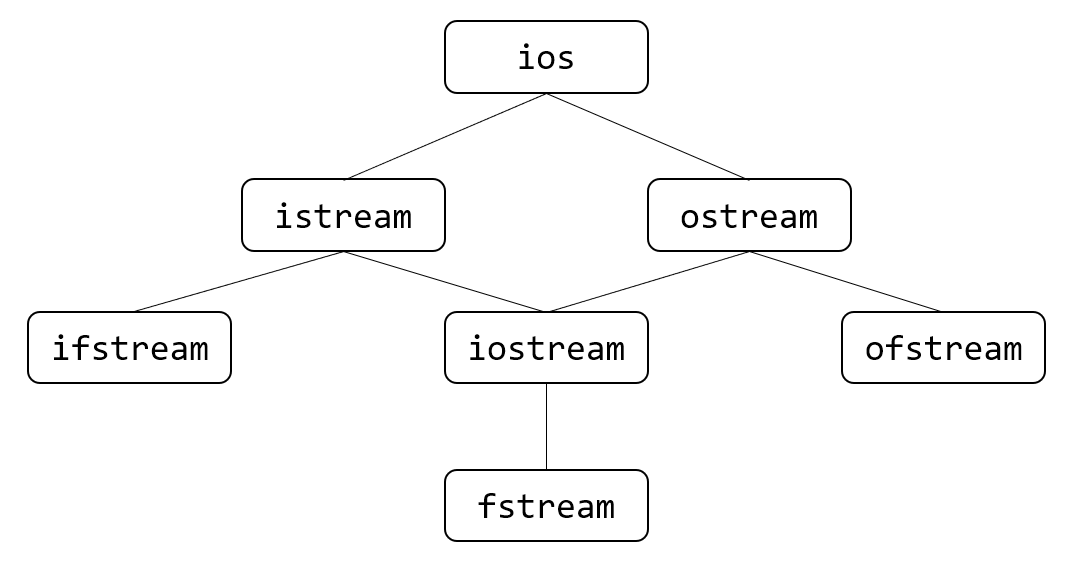 C++ 输入输出流
C++ 输入输出流
# C++ 输入输出流
# 输入输出流基本概念
与输入输出流操作相关的类:类的继承关系从上往下如下图所示

istream:用于输入的流类,cin是该类的对象ostream:用于输出的流类,cout cerr clog是该类的对象ifstream:用于从文件读取数据的类ofstream:用于向文件写入数据的类iostream:既能用于输入,又能用于输出的类fstream:既能从文件读取数据,又能向文件写入数据的类
标准流对象:
cin对应于标准输入流,用于从键盘读取数据,也可以被重定向为从文件中读取数据cout对应于标准输出流,用于从屏幕输出数据,也可以被重定向为向文件写入数据cerr对应于标准错误输出流,用于向屏幕输出出错信息clog对应于标准错误输出流,用于向屏幕输出错误信息cerr和clog的区别在于cerr不使用缓冲区,直接向显示器输出出错信息;而clog中的信息先会被存放到缓冲区,缓冲区满或者刷新时才输出到屏幕。
istream 类的成员函数:
istream & getline(char* buf, int bufSize);:从输入流中读取bufSize-1个字符到缓冲区buf或读到碰到\n为止istream & getline(char* buf, int bufSize, char delim);:从输入流中读取bufSize-1个字符到缓冲区buf或读到碰到字符delim为止。如果一次读入的字符个数超过了bufSize-1不会影响本次读入,但是之后的读入都会失败。另外,可以用getline()的返回值判断输入是否结束if(!cin.getline())。bool eof();判断输入流是否结束int peek();返回下一个字符,但不从输入流中去掉istream & putback(char c);将字符c放回输入流iostream & ignore(int nCount = 1, int delim = EOF);从流中删掉最多nCount个字符,遇到 EOF 时结束
流操纵算子控制输出格式:
int main(){
// 分别以十六进制、十进制、八进制先后输出 n
int n = 141;
cout << "1) " << hex << n << " ";
cout << dec << n << " ";
cout << oct << n <<endl;
// 保留 5 位有效数字
double x = 1234567.89, y = 12.34567;
cout << "2) " << setprecision(5) << x << " " << y <<endl;
// 保留小数点后 5 位 定点输出浮点数
cout << "3) " << fixed << setprecision(5) << x << " " << y <<endl;
// 科学计数法输出,且保留小数点后 5 位
cout << "4) " << scientific << setprecision(5) << x << " " << y <<endl;
// 非负数要显示正号,输出宽度为 12 字符, 宽度不足则用 * 号填补
cout << "5) " << showpos << fixed << setw(12) << setfill('*') << 12.1 <<endl;
// 非负数不显示正号,输出宽度为 12 字符, 左对齐 宽度不足则右边用填充字符填补
cout << "6) " << noshowpos << setw(12) << left << 12.1 <<endl;
// 输出宽度为 12 字符,右对齐 宽度不足则左边用填充字符填补
cout << "7) " << setw(12) << right << 12.1 << endl;
// 宽度不足时,符号和数值分列左右,中间用填充字符填补
cout << "8) " << setw(12) << internal << -12.1 <<endl;
cout << "9) " << 12.1 <<endl;
return 0;
}
# 文件读写
# 创建文件
调用头文件 #include <fstream> 中的函数ofstream outFile("data.txt", ios::out|ios::binary); 创建文件,其中第一个参数表示要创建的文件的名字 data.txt;ios::out 表示文件打开方式,out 表示输出内容到该文件,删除原有文件内容,app 表示输出内容到该文件,保留原有内容,从尾部追加;ios::binary 表示以二进制文件格式打开文件。
除了 直接创建 ofstream 对象 outFile 也可以先创建对象,再用 open 函数打开该文件,形如 ofstream fout; fout.open("data.txt", ios::out|ios::binary) 。判断文件是否打开可以直接使用被重载的 ! 运算符,if(!fout){} 进行判断。
# 文件的读写指针
文件的读写指针并不是真正意义上的指针,它用来表示文件操作的当前位置,该指针在那里,读写操作就在哪里进行。对于输入文件,有一个读指针;对于输出文件,有一个写指针;对于输入输出文件,有一个读写指针。
输出文件,写指针:tellp()/seekp()
ofstream fout("test.out", ios::app);
long location = fout.tellp(); // 获取写指针的位置
location = 10; // location 可以为负值
fout.seekp(location); // 将写指针移动到第10个字节处
fout.seekp(location, ios::beg); // 从文件头开始移动location个字节
fout.seekp(location, ios::cur); // 从当前位置开始移动location个字节
fout.seekp(location, ios::end); // 从文件尾开始移动location个字节
输入文件,读指针:tellg()/seekg()
ifstream fin("test.in", ios::ate); // 打开文件并将读指针定位到文件末尾
long location = fin.tellg(); // 获取写指针的位置
location = 10; // location 可以为负值
fin.seekg(location); // 将读指针移动到第10个字节处
fin.seekg(location, ios::beg); // 从文件头开始移动location个字节
fin.seekg(location, ios::cur); // 从当前位置开始移动location个字节
fin.seekg(location, ios::end); // 从文件尾开始移动location个字节
字符文件读写:实践示例 将文件 in.txt 里面的整数排序后,输出到 out.txt
#include <iostream>
#include <fstream>
#include <vector>
#include <algorithm>
using namespace std;
int main(){
vector<int> v;
ifstream srcFile("in.txt", ios::in);
ofstream destFile("out.txt", ios::out);
int x;
while (srcFile >> x)
{
v.push_back(x);
}
sort(v.begin(), v.end());
for(int i=0; i< v.size(); i++){
destFile << v[i] << " ";
}
destFile.close();
srcFile.close();
return 0;
}
# 二进制文件读写
二进制读文件:
二进制读文件可以使用 ifstream 和 fstream 的成员函数 istream& read(char* s, long n);,read 函数的作用是将文件读指针指向的地方的 n 个字节内容,读入到内存地址 s,然后将文件读指针向后移动 n 个字节;如果文件使用 ios::in 的方式打开文件,文件的读指针开始指向文件开头。
二进制写文件:
二进制写文件可以使用 ofstream 和 fstream 的成员函数 istream& write(const char* s, long n);,write 函数的作用是将内存地址 s 处的 n 个字节内容,写入到文件中写指针指向的位置,然后将文件写指针向后移动 n 个字节;如果文件使用 ios::out 的方式打开文件,文件的写指针开始指向文件开头;ios::app 方式打开文件时,文件写指针最开始指向文件尾部。
#include<iostream>
#include<fstream>
int main(){
ofstream fout("data.dat", ios::out|ios::binary);
int x=120;
fout.write((const char *)(&x), sizeof(int));
fout.close();
ifstream fin("data.dat", ios::in|ios::binary);
int y;
fin.read((char *)(&y), sizeof(int));
fin.close();
cout << y << endl;
return 0;
}
文件读写实例-文件拷贝:将 ori.dat 拷贝到 dest.dat ,如果目标文件存在就将其原始文件覆盖。
#include <iostream>
#include <fstream>
using namespace std;
int main(int argc, char* argv[]){
if(argc != 3){
cout << "file name missing1" << endl;
return 0;
}
// 读取二进制文件
ifstream inFile(argv[1], ios::binary|ios::in);
if(!inFile){
cout << "Source file open error." << endl;
return 0;
}
// 写入二进制文件
ofstream outFile(argv[2], ios::binary|ios::out);
if(!outFile){
cout << "New file open error." << endl;
inFile.close();
return 0;
}
// 拷贝文件
char c;
while(inFile.get(c)){ // 每次从源文件读取一个字符
outFile.put(c); // 每次写入一个字符到目标文件
}
outFile.close();
inFile.close();
return 0;
}
